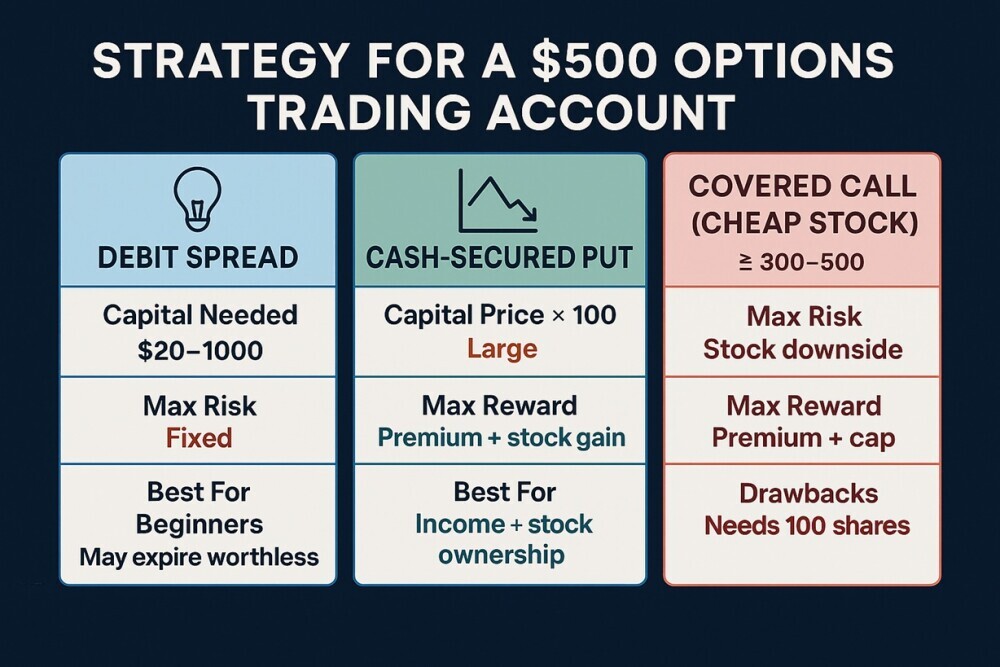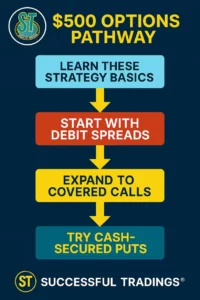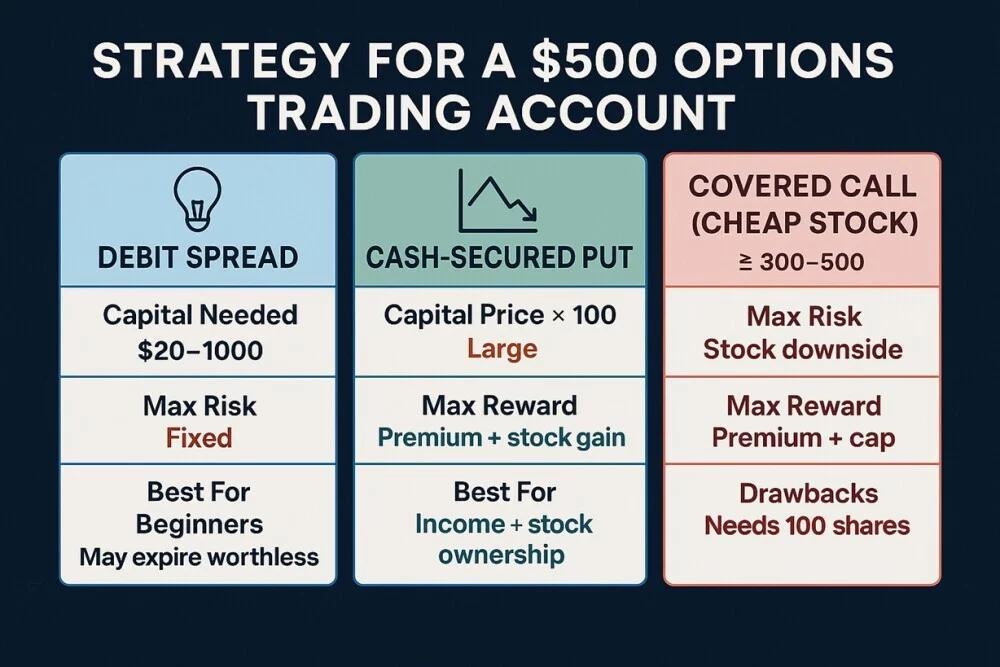Table of Contents
Introduction
Many traders hesitate to start options trading because they believe a large account is required. However, even with just $500, you can build skills, gain market experience, and grow your trading capital responsibly. The key is using defined-risk strategies, focusing on risk management, and approaching the market with the right mindset.
In this post, I’ll walk you through how to start trading options with $500, which strategies work best, and how to avoid the common mistakes that blow up small accounts.

Step 1: Set Up Your Broker Account
Your first step is selecting a broker that supports options trading while offering low commissions. Brokers such as Webull, Robinhood, E*TRADE, and TD Ameritrade are popular with beginners. Look for features like paper trading tools, real-time option chains, and no minimum balance requirements. Remember, since your account is small, every dollar in fees matters.
Pro Tip: Confirm your broker allows spreads and not just single-leg options. Defined-risk spreads are crucial for small accounts.
Step 2: Broker Accounts & Approval Levels
Most brokers don’t give you full option privileges on day one. With a $500 account, you’ll typically qualify for Level 1 or 2 approval. That means you can trade cash-secured puts, covered calls, and debit spreads — but not naked selling or advanced margin strategies.
- Cash Account: You trade with only the money you deposit. This is usually where beginners start.
- Margin Account: Lets you borrow money to trade, but $500 may not qualify for advanced margin usage. Some spreads require margin approval, so check with your broker.
👉 Always apply for the highest level you think you’ll need, but understand brokers want to see experience and capital before granting advanced levels.
Step 3: Adopt the Small Account Mindset
With $500, every mistake gets amplified. You can’t afford to gamble or “yolo” into trades. Instead, your focus must be:
- Risking no more than 2–5% of your account on each trade (that’s $10–$25).
- Treating losses as tuition, not disasters.
- Aiming for consistent, repeatable trades rather than lottery wins.
Trading is a game of discipline, not predictions. Think of yourself as a risk manager first, trader second.
Step 4: Choose the Right Strategies for $500
When starting with limited capital, stick to strategies that keep losses capped.
1. Debit Spreads
A debit spread (e.g., call debit spread) involves buying one option and selling another at a higher strike. This lowers your cost and limits your risk.
- Example: Buy SPY $440 call, sell SPY $445 call.
- Cost: ~$50 (well within a $500 account).
- Max Loss: Limited to the premium paid.
Debit spreads allow you to control risk tightly and trade high-quality setups without betting the farm.
2. Cash-Secured Puts
If you want to own stock, cash-secured puts are a great entry.
- Example: Sell a put option on a $10 stock.
- You collect premium, and if assigned, you buy shares at the strike price.
- This ties up cash but acts like a discounted stock entry.
3. Covered Calls (If You Own Shares)
If you own at least 100 shares of a stock, you can sell covered calls to collect income.
With $500, this works only on cheaper stocks (under $5). It’s less flexible, but it’s a way to generate steady income.
| Strategy | Capital Needed | Max Risk | Max Reward | Best For | Drawbacks |
|---|---|---|---|---|---|
| 💡 Debit Spread | $20–$100 | Fixed | Fixed | Beginners | May expire worthless |
| 📉 Cash-Secured Put | Stock Price × 100 | Large | Premium + stock gain | Income + stock ownership | Ties up most of $500 |
| 📈 Covered Call (cheap stock) | ≥ $300–500 | Stock downside | Premium + cap | Stockholders | Needs 100 shares |
Step 5: Risk Management
The most important part of trading with $500 is preserving capital.
- Rule 1: Never risk more than $25 per trade.
- Rule 2: Avoid overtrading — quality setups matter more than quantity.
- Rule 3: Use stop-loss orders or mental exits to stay disciplined.
- Rule 4: Track every trade in a journal. Even small accounts need a system.
Remember: Blowing up means no second chance. Surviving means you can keep learning.
Step 6: GTC vs. Day (When to Use Which)
When placing a limit order, you’ll usually see two choices for how long the order stays active: Day or Good-Till-Cancelled (GTC). Each serves a different purpose depending on your trading style and timeframe.
- Day Orders: Remain active only for the current trading session. Expire if not filled by the close. Best for short-term trades and active monitoring.
- GTC Orders: Stay open until executed or cancelled (broker limits apply, often 30–90 days). Best for swing traders and long-term investors waiting for a price target.
👉 When to use which: Use Day orders if you’re actively trading and monitoring intraday. Use GTC if you have a clear entry/exit target but don’t want to babysit the trade.
Step 7: Alternatives Before Going Live
If you’re nervous about risking real money, start with paper trading or simulators.
This builds confidence without losing cash.
Also consider fractional shares or micro options, which let you practice the same skills with even smaller capital.
Step 8: Avoid Common Beginner Mistakes
Beginners often sabotage themselves by:
- Chasing weekly “lotto” options that expire in days.
- Trading too large relative to their account.
- Ignoring commissions and slippage.
- Trading without a plan.
With $500, mistakes get magnified. Play defense first.
Illustrative Example
Let’s imagine you have $500 and decide to risk $20 on a debit spread:
- Trade: Buy AMD $110 call, sell AMD $115 call.
- Cost: $20.
- Max Gain: $480 (if AMD moves above $115).
Even if the trade loses, your maximum loss is capped. Repeat this process consistently, and you’ll learn faster without risking ruin.
Beginner Pitfall Story
A trader with $500 once went all-in on weekly calls, hoping to double overnight.
The stock dropped instead, wiping out the account. Had they used a debit spread, the maximum loss would have been a fraction, preserving capital and confidence.
The lesson: small accounts can’t afford recklessness.
FAQs
Q: Can I really start options trading with only $500?
Yes, but you need strict risk management and defined-risk strategies like spreads.
Q: What’s the best strategy for beginners with small accounts?
Debit spreads are often the best choice due to low cost and capped risk.
Watch this Debit Spreads Complete Tutorial on Youtube.

Q: Can I sell naked options with $500?
No. Naked options require huge margin and expose you to unlimited risk.
Q: How many trades should I take per week?
Focus on 1–3 high-quality setups, not constant trading.
Q: Should I paper trade first?
Absolutely. Use paper trading to build confidence before risking real money.
Q: Can I trade spreads with $500?
Yes, debit spreads typically cost $20–$50 and fit perfectly in small accounts.
Q: What broker is best for a $500 options account?
Brokers with no minimums and low fees like Webull, Robinhood, or Fidelity are good starting points.
Q: How fast can I grow $500 trading options?
Small accounts can grow quickly, but they can also go to zero. Focus on consistency over speed.
Conclusion
You don’t need thousands of dollars to begin options trading. With the right mindset, risk control, and strategies like debit spreads or cash-secured puts, even a $500 account can help you grow skills and build confidence.
👉 Next Step: Download my free Options Trader’s Toolbox to get templates and guides designed for small account traders.
Then watch the recommended video below for a visual walkthrough.
📹 Recommended Video
Watch this breakdown on my YouTube channel: How to Trade Options with a Small Account (Step-by-Step) → Successful Tradings YouTube Channel

Hold a Master Degree in Electrical engineering from Texas A&M University.
African born – French Raised and US matured who speak 5 languages.
Active Stock Options Trader and Coach since 2014.
Most Swing Trade weekly Options and Specialize in 10-Baggers !
YouTube Channel: https://www.youtube.com/c/SuccessfulTradings
Other Website: https://237answersblog.com/

